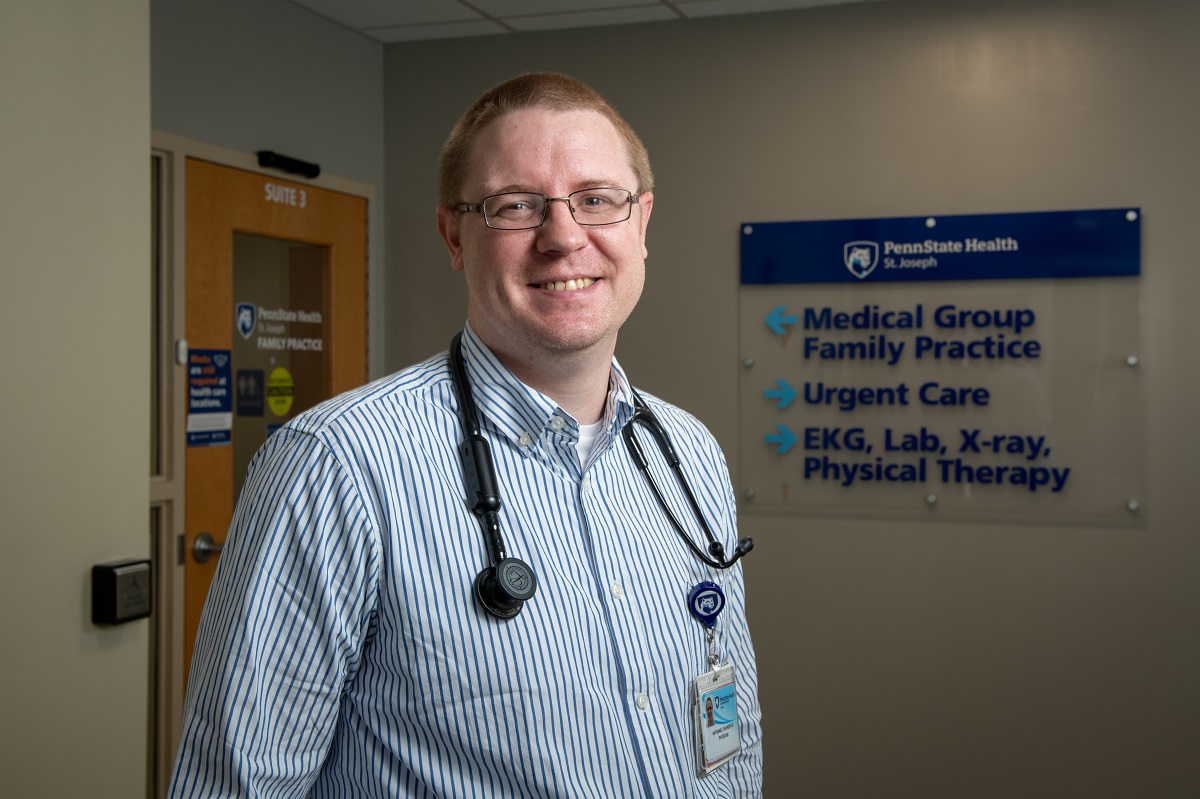St. Joseph Medical Center connections run deep for Strausstown family physician

For Dr. Nathaniel Ohlinger, joining the Penn State Health Medical Group – Strausstown family practice somehow feels preordained.
“I owe my existence to St. Joseph Hospital,” said the 36-year-old Ohlinger with a chuckle, explaining that his parents worked together at the original hospital at 12th and Walnut Street in Reading, where he also was born. “I think I was contractually obligated to come back.”
All joking aside, the Berks County native’s association with the Penn State Health community hospital doesn’t end there. Both of his aunts – Mary McDevitt, cardiothoracic nurse coordinator, and Ann Welsh, lead mammography technologist – have worked for the hospital their entire careers. And Ohlinger, who knew as a child that he wanted to be a doctor, worked for St. Joseph Medical Center as a lab assistant and phlebotomist before entering college.
Despite those connections, his path back followed anything but a straight line.
Medical school delayed by military deployment
After graduating in 2008 from the University of Scranton with a biology degree, Ohlinger accepted a commission in the U.S. Army.
“I was a medical platoon leader with the 109th Field Artillery regiment in Wilkes Barre, Pa., close to where I went to college,” he said, adding that he took the opportunity to go back to school and complete a master’s degree in biochemistry. In 2012, just after applying to medical school, he was deployed to Kuwait with Charlie Company 1-109 Infantry Regiment PAARNG. “After I came back from that deployment, I went back to the University of Scranton as an ROTC instructor, teaching military tactics and leadership to college freshmen.”
Sensing the time was right, Ohlinger reapplied to medical school and was accepted at West Virginia School of Osteopathic Medicine. Fast-forward to his fourth year, and he returned to the Reading area to complete many of his clinical rotations at St. Joseph Medical Center.
“I knew I wanted to stay here. It’s home,” he said. It was also the site of Penn State’s three-year Family and Community Residency Program and the perfect training ground for Ohlinger.
Family and community medicine proves a good fit
“When you go through all those clinical rotations, you get a sense, personality-wise, of what kind of doctor you’re most likely to be. I always felt most comfortable in family medicine,” he said. “Fortunately for me, they liked me enough to welcome me into their program.”
Once there, Ohlinger knew he had made the right decision.
“I like the agility that you have to have in family medicine because patients with any health issue can walk through your door at any time,” he said. “I like that I enter into a partnership with the patient, and we make decisions together.”
Strausstown family practice is where Ohlinger wants to be
During his residency, Ohlinger encountered Strausstown family physician Dr. Krista Schenkel, who serves as a member of the faculty. A fan since working with her in the procedure clinic, he lobbied for the opportunity to work together following graduation.
“I always admired her professionalism and early on let her know I was interested in learning more about the practice,” he says, adding that he welcomes the opportunity to have Schenkel as a workplace mentor. “Even though I gained a lot of independence by my third year, I’m in an environment where I feel safe being able to grow and learn.”
It’s also exactly where Ohlinger wants to be.
“I came back to Reading to be near my family and because I knew Penn State Health had a great community and family medicine residency program,” he says. “Now it’s my turn to give back to the community that’s helped me.”
If you're having trouble accessing this content, or would like it in another format, please email Penn State Health Marketing & Communications.
